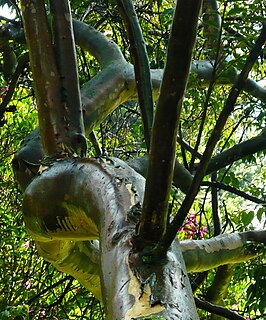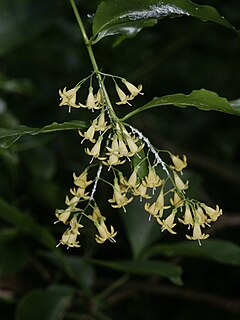Conceveiba is a plant genus of the family Euphorbiaceae, first described as a genus in 1775. It is native to South America and Central America.
- Conceveiba guianensisAubl. - Brazil, Peru, Bolivia, Ecuador, Colombia, Venezuela, 3 Guianas
- Conceveiba hostmaniiBenth. - Guyana, Suriname, Amazonas State in Brazil
- Conceveiba krukoffiiSteyerm. - Venezuela, French Guiana, NW Brazil
- Conceveiba latifoliaBenth. - Colombia, Venezuela, Peru, Amazonas State in Brazil
- Conceveiba martianaBaill. - Venezuela, French Guiana, NW Brazil, Colombia, Ecuador, Peru, Bolivia
- Conceveiba maynasensisSecco - Loreto in Peru
- Conceveiba parvifoliaMcPherson - Panama, NW Colombia
- Conceveiba pleiostemonaDonn.Sm. - Costa Rica, Nicaragua, Colombia, Venezuela
- Conceveiba praealta(Croizat) Punt ex J.Murillo - NW Brazil
- Conceveiba ptariana(Steyerm.) Jabl. - S Venezuela
- Conceveiba rhytidocarpaMüll.Arg. - Colombia, Ecuador, Peru
- Conceveiba santanderensisJ.Murillo - NW Colombia
- Conceveiba terminalis(Baill.) Müll.Arg. - Venezuela, Guyana, Suriname, NW Brazil, Colombia, Peru
- Conceveiba tristigmataJ.Murillo - Colombia, Venezuela, NW Brazil
Brewcaria is a genus of plants in the family Bromeliaceae. The genus is named for Charles Brewer-Carías, Venezuelan explorer and naturalist. It contains 6 known species, all native to Colombia and Venezuela.

Calycolpus is a genus of the botanical family Myrtaceae, first described as a genus in 1856. It is native to the South America, Central America, and the West Indies.
Chimantaea is a genus of flowering plants in the aster family, Asteraceae.

Chiococca is a genus of flowering plants in the family Rubiaceae. It currently holds 23 species that are native to Florida, Texas, Mexico, Central America, much of South America, the West Indies, and the islands of Galápagos and Fernando de Noronha.

Tinantia is a genus of plants in the Commelinaceae, first described in 1839. They are commonly called widow's tears or false dayflowers due to their resemblance of the closely related true dayflowers of the genus Commelina. Tinantia is native to North and South America from Texas + Hispaniola to Argentina, with a center of diversity from Mexico to Nicaragua. Tinantia pringlei, an alpine native of Mexico, is grown as an ornamental in temperate areas and is also a common greenhouse weed.

Chomelia is a genus of flowering plants in the family Rubiaceae. It is native to Mexico, Central America, the West Indies, and much of South America as far south as Argentina.

Calycophyllum is a genus of flowering plants in the family Rubiaceae. It was described by Augustin Pyramus de Candolle in 1830. The genus is found from Mexico, Central America, South America and the West Indies.
Gleasonia is a genus of plants in the Rubiaceae. There are at the present time five accepted species, all native to South America.
Nietneria is a genus of plants in the Nartheciaceae. It has two known species, both native to northern South America.

Orectanthe is a genus of flowering plants, in the family Xyridaceae, first described as a genus in 1958. It is native to the tepui of northern South America. It is closely related to Abolboda, and both known species were originally classified as members of Abolboda before being transferred to Orectanthe.
Sipaneeae is a tribe of flowering plants in the family Rubiaceae and contains about 43 species in 10 genera. Its representatives are found from Central to Southern Tropical America.
Bassett Maguire was an American botanist, head curator of the New York Botanical Garden, and a leader of scientific expeditions to the Guyana Highlands in Brazil and Venezuela.
Celiantha is a genus of flowering plants belonging to the family Gentianaceae.
Everardia is a genus of flowering plants belonging to the family Cyperaceae.
Maguireocharis is a monotypic genus of flowering plants belonging to the family Rubiaceae. It only contains one known species, Maguireocharis neblinaeSteyerm.
Neblinathamnus is a genus of flowering plants belonging to the family Rubiaceae.
Sipaneopsis is a genus of flowering plants belonging to the family Rubiaceae.
Maguireanthus is a monotypic genus of flowering plants belonging to the family Melastomataceae. The only species is Maguireanthus ayangannaeWurdack.
Ernestia is a genus of plant in family Melastomataceae.





